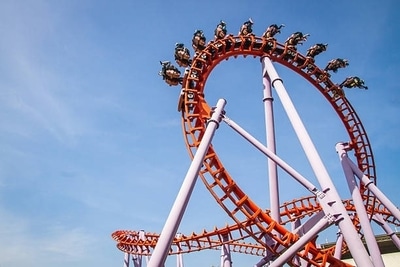By Patrick J. Glinka, Esq.
California is home to some of the world’s best amusement parks. And with the beautiful summer weather upon us and COVID restrictions slowly lifting, many of us can’t wait to be amused. But have you ever given much thought about who might be liable if someone gets injured on a ride? After all, rides are increasingly complex, with features designed to excite and thrill – giving riders the sensations of being unsafe, but ultimately bringing them back in one piece. But what if it doesn’t? Who is liable and what standard will be used to judge them? California law may not be so clear and leaves us with something to keep in mind next time we choose our rides at Disneyland, Knott’s Berry Farm, Great America or Six Flags.
The legal standard we have all become familiar with is that everyone is required to use reasonable care to prevent harm to others. Moreover, a person who owns, leases, occupies or controls property is required to keep that property in a reasonably safe condition. However, what if that property happens to have a roller coaster on it? Do the “reasonable care” and “reasonably safe” standards still apply? This was addressed by the California Supreme Court in Gomez v. Superior Court (2005) 35 Cal.4th 1125.
In Gomez, a park patron sustained head injuries while on the “Indiana Jones” amusement ride at Disneyland and subsequently died. The ride, which cost over $100 million to design and build, carried passengers in an off-road jeep on a predetermined track that included jarring jumps, drops and unpredictable movements. It appeared that the ride had operated as intended. The issue for the California Supreme Court to determine was what standard Disneyland would be held to. The plaintiffs argued that the familiar “reasonable care” standard did not apply. Instead, they pointed to a law enacted in 1872 (during the time of horse drawn carriages!) that required anyone “carrying” passengers for hire to use “utmost care” and “diligence” in protecting their passengers. If they failed in any respect, they would be found liable. Predictably, Disneyland disagreed, arguing that the law was antiquated and really only meant to apply to those transporting people from one place to another – not an amusement park ride.
The California Supreme Court disagreed with Disneyland. It found no difference between transporting people from place to place or for mere amusement. Further, the court reasoned that these “common carrier” laws were meant to protect those who entrusted their safety to others and had no practical ability to protect themselves while under another’s control. That existed whether it was a stagecoach or a roller coaster. But what if amusement park patrons had some control over their safety? Would things be any different? That was addressed next by the California Supreme Court in Nalwa v. Cedar Fair, L.P. (2012) 55. Cal.4th 1148.
In Nalwa, the plaintiff suffered a broken wrist while bracing herself in a bumper car at Great America. The plaintiff argued that Great America should be held to the heightened duty of care of common carriers, as Disneyland was in Gomez. Remarkably, the California Supreme Court rejected the plaintiff’s argument, finding that bumper cars were a different type of ride than traditional roller coasters because operators could control their speed and direction of travel. To add insult to injury, the court went further, finding that the risk of injuries from bumping into other cars was inherent to the ride and applied California’s primary assumption of the risk doctrine to preclude the plaintiff’s claims all together.
The California Supreme Court’s decisions in Gomez and Nalwa make clear that not all amusement rides will be judged by the same standard. A passenger’s ability to control his or her environment appears to be the deciding factor. This would explain a recent decision by the California Court of Appeals in Sharufa v. Festival Fun Parks, LLC (2020) 49 Cal.App.5th 493.
The ride at issue in Sharufa was a waterslide. It had a predetermined track like the ride in Gomez, but the patron had some control over the movement of his inner tube, like the bumper cars in Nalwa. Unfortunately, the patron fell off his tube during the ride and injured himself in the splash pool at the end. The appellate court found that the heightened “common carrier” applied to the waterslide. In making its decision, the central issue for the court was that the waterslide, like a rollercoaster, was designed to give the patron a sensation of danger without really putting the patron in danger. The take away from Sharufa appears to be that where an amusement park expects patrons to trust that its rides are safe, it should be held to a higher “common carrier” standard.
For the average amusement park patron, the distinctions discussed in Gomez, Nalwa and Sharufa won’t likely cross their mind when choosing a ride. Fortunately, as rides become ever more complex and riders become more or less captive audiences, these distinctions in the law will slowly fade in favor of the amusement park’s “utmost care” standard. However, it is always a good idea for each amusement park patron to assess their own physical health and comfort level before riding any ride so as to avoid potential injury.
If you have any questions as to how this ruling might affect your business, feel free to contact Bradley, Gmelich & Wellerstein LLP so we can help you with your specific needs.

Patrick J. Glinka, Esq. is Special Counsel at Bradley, Gmelich & Wellerstein LLP. Mr. Glinka had defended clients in a broad range of civil litigation matters, including medical malpractice, products liability, premises liability and amusement and recreation liability. His experience includes many first chair jury verdicts, as well as appellate advocacy. Mr. Glinka is a graduate of the National Institute of Trial Advocacy and a member of the International Amusement & Leisure Defense Association and Defense Research Institute.
Mr. Glinka obtained his B.A. in History from the University of Massachusetts, Amherst in 1998 and his J.D. from Roger Williams University School of Law in 2001. Mr. Glinka is admitted to the State Bar of California, Massachusetts and Connecticut and qualified to practice law in all three states.
pglinka@bgwlawyers.com

